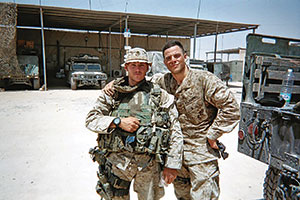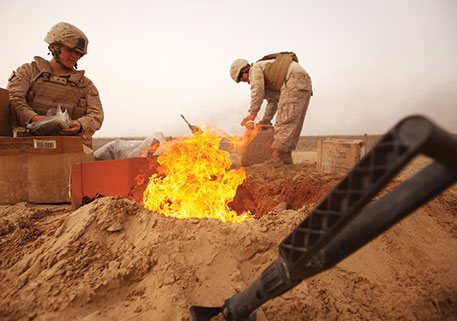
Former Marine Corps scout sniper Alexander Lemons is one of countless veterans battling the effects of the “toxic triangle”—a deadly intersection of toxic exposure, traumatic brain injury (TBI) and post-traumatic stress disorder (PTSD) that is common among combat veterans. These invisible injuries often overlap, making diagnosis, treatment and recovery exponentially more complex.
“As infantry veterans, we expect injuries like torn rotator cuffs, aching knees and compressed vertebrae,” Lemons said. “But what you don’t expect is stories of coughs, headaches, breathing problems and other mysterious illnesses.”
Lemons’ time in uniform and exposure to this triangle included three combat deployments to Iraq, where he took part in the 2003 invasion, the Battle of Najaf against the Mahdi Army, the bloody Second Battle of Fallujah—the largest urban assault by U.S. forces since Vietnam—and heavy fighting in Ramadi. He later served as a special assistant to Army Gen. David Petraeus.
Lemons’ warfighting role placed him in near-constant proximity to death and violence, leading to emotional desensitization, moral injury and psychological strain, all hallmarks of PTSD. But his fellow Marines had no idea he was struggling.
“My routine with food became rigid,” Lemons said. “I began to weigh food, and it started to have no taste. I took no pleasure in food and began to drop weight.”
Between deployments, Lemons endured countless hospital visits for a mysterious illness. Doctors eventually discovered that an unknown virus had attacked his body. But it wasn’t just physical. At the same time, Lemons was fighting a psychological battle he didn’t yet understand.
Adding to his invisible wounds, Lemons was also repeatedly exposed to environmental toxins. The list was long: lead from ammunition; JP-8 jet fuel; firefighting foam; thick clouds of dust from Iraqi sandstorms; and, perhaps worst of all, open-air burn pits.
“Lithium radio batteries, blown-out tires, oil containers, brass ammo casings, medical waste and plastics were all thrown into a pit,” he recalled. “We would douse it with JP-8 and light it with matches from rations until another Marine would relieve us.”
Fellow Iraq War veteran Dan Clare was serving in the Air Force in Iraq in 2006 when he came across a Department of Defense memo acknowledging the health hazards of those burn pits.
“The government knew that the burn pits were toxic at the time,” said Clare, who serves as DAV’s chief communications and outreach officer. “This was on top of the other hazards deployed people were facing, especially the folks outside the wire. Lives were being saved at the Air Force Theater Hospital, but anyone operating on the base was being exposed daily.”
Burn pit exposure has since been linked to serious health issues, ranging from chronic respiratory diseases to neurological and cardiovascular conditions.
Lemons separated from the Marines in 2009 and filed for disability benefits from the Department of Veterans Affairs. At the George E. Wahlen VA Medical Center in Salt Lake City, he sought answers for undiagnosed health issues and treatment for PTSD.
During intake, clinicians uncovered the extent of his mental health struggles and his battle with disordered eating. He was diagnosed with PTSD and anorexia nervosa and referred to both an eating disorder specialist and a psychiatrist for intensive behavioral therapy.
According to a study published in the journal Military Medicine, trauma-exposed veterans face an elevated risk for eating disorders. The 2022 study revealed that nearly 8% of men and 19% of women returning from Iraq and Afghanistan self-reported symptoms of an eating disorder.
“There is no one-size-fits-all model for treating PTSD and eating disorders,” said DAV Deputy National Legislative Director Jon Retzer. “The VA’s understanding of military culture and its use of evidence-based treatments provide the specialized care needed to address the complex relationship between these two conditions.”

Lemons also pursued a TBI screening and continued investigating the long-term effects of the virus he contracted during service. He was eventually diagnosed with severe plantar fasciitis but was not found to have sustained a TBI.
Still, the chronic cough, headaches, joint stiffness, fatigue, memory issues, and skin and eye irritation persisted. Frustrated by a lack of answers, Lemons turned to alternative therapies outside the VA. His private doctors ultimately determined he had heavy metal poisoning, likely stemming from his service-related toxic exposures.
Armed with this new information, Lemons filed a new VA disability claim related to toxic exposure. But a VA examiner ruled that none of his symptoms were linked to his deployments in Iraq.
“Burn pits are our generation’s Agent Orange,” Lemons said. “I have the receipts—and so does everybody else that served near them.”
Although the PACT Act addressed many long-standing gaps in care for veterans harmed by burn pits and other known exposures, it didn’t cover all toxic wounds or reform the process for how the VA presumes connections between service and illness.
To fix that, DAV and the Military Officers Association of America (MOAA) released Ending the Wait for Toxic-Exposed Veterans: A Post-PACT Act Blueprint for Reforming the VA Presumptive Process. The 2024 report proposes a new framework to comprehensively improve how the VA responds to toxic wounds, ensuring that veterans like Lemons no longer fall through the cracks.
Despite the setbacks, Lemons has never stopped working to reclaim his health. Today, he works as an environmental restoration technician in Utah and has chronicled his military service and the lasting effect of toxic exposure in a new memoir, “Warbody: A Marine Sniper and the Hidden Violence of Modern Warfare.”
“While the PACT Act was a generational legislative victory,” Retzer said, “stories like Alexander Lemons’ remind us that the job is far from over. We must do everything possible to finally end the wait for toxic-exposed veterans.”






